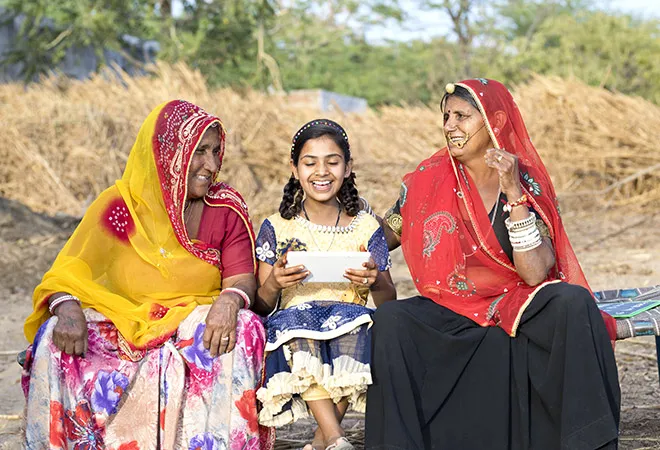-
CENTRES
Progammes & Centres
Location
The world’s largest rural broadband project, BharatNet, has had multiple setbacks, but strategic partnerships with the private sector could help it turn the corner.

At an Associated Chambers of Commerce and Industry of India (ASSOCHAM) conference in late October, Rajeev Chandrasekhar, the Minister of State for Electronics and IT spoke enthusiastically of how the rapid growth of India’s internet user base would soon make India ‘one of the largest connected nations in the world’. A particular focus of Chandrasekhar’s speech was the importance of BharatNet, the government’s flagship rural broadband connectivity project. BharatNet, he felt, would be instrumental in ‘lighting up homes in villages’ and would eventually lead to ‘1.5 billion Indians being connected to the Internet over the next two years’.
In 2014, the Narendra Modi government inherited the National Optical Fibre Network initiative that had been launched in 2011, rebranded it as ‘BharatNet’, and introduced several changes to its structure and operations. It was then given a new impetus by making it a pillar of the Digital India programme.
BharatNet’s goal is to provide high-speed broadband connectivity to the 250,000-plus village panchayats spread across India’s 6,600 blocks and 640 districts. It is to act as a middle-mile network from blocks to panchayats allowing Internet service providers (ISPs), local cable operators, and other agencies to use its bandwidth and incremental fibre. In doing so, it will facilitate access to e-governance, telemedicine, e-education, and other digital services at the primary level of village administration. Since 2017, the project has also sought to provide last-mile connectivity by setting up Wi-Fi hotspots in villages.
BharatNet’s goal is to provide high-speed broadband connectivity to the 250,000-plus village panchayats spread across India’s 6,600 blocks and 640 districts.
Widely publicised as the world’s largest fibre-based rural broadband project, BharatNet has had ambitious—but constantly shifting—timelines for execution. According to the National Digital Communications Policy (NDCP), it aimed to provide connectivity of 1 Gbps to every panchayat by 2020, upgradeable to 10 Gbps by 2022. With the latter date looming large, it is worth taking stock of where the initiative stands today.
Bharatnet has a sweeping vision and the potential to transform rural India. Unfortunately, almost since inception, its progress has been marred by operational setbacks, poor execution, incessant delays, and the lack of a coherent strategy for engaging with stakeholders.
Of the 250,000 village panchayats that were to have functional broadband by 2020, roughly 70 percent has optical fibre cable (OFC) connection installed, but only around 65 percent are actually connected to the OFC. The quality of service at panchayats has come in for severe criticism. Once panchayats were provided connectivity by BharatNet, private players were expected to step in readily to lease bandwidth and offer the Internet at the last mile. But the unreliability of the BharatNet infrastructure and its poor maintenance have resulted in relatively little interest from private sector Internet Service Providers (ISP). The project’s own attempts to offer last-mile connectivity via Wi-Fi have faltered—only a fraction of the expected number of hotspots has been installed, and the majority of them do not work.
Panchayats across India have long complained of frequent line faults, excessive downtime, and the near-customary lack of response to service requests. This is at least partly explained by a damning CAG report about BharatNet released in July this year. Astonishingly, it turns out that the service-level agreements governing BharatNet’s implementation do not include provisions for penalising the handsomely paid Common Service Centres (CSC) tasked with maintaining the project’s OFC network. As always, the ultimate casualties of these oversights are the end users—the village officials forced to switch to mobile data, and community members who will never benefit from fibre-to-the-home (FTTH).
The project’s own attempts to offer last-mile connectivity via Wi-Fi have faltered—only a fraction of the expected number of hotspots has been installed, and the majority of them do not work.
Until very recently BharatNet had made no serious attempt to collaborate with the private sector. Historically, it has demonstrated a clear bias towards the selection of central public sector undertakings to manage its implementation. The inefficiencies of this approach have been apparent for years, and as early as 2016 the Telecom Regulatory Authority of India had recommended the establishment of a public-private partnership (PPP) to execute the project. But it was only in June 2021—after five more years of throwing good money at flawed practice—that BharatNet chose to ‘course correct’. It is currently in the process of entering into a PPP with private stakeholders who will help roll out BharatNet across 16 states, deploy innovative new technologies for consumers, and build sustainable revenue generation models. The private partners will also be made responsible for operating, upgrading and maintaining BharatNet for the next 30 years. Understandably, the private sector has responded with cautious interest. There are no precedents for a PPP of this scale in India. Companies know they are being called in to fix the failures and stasis of nearly a decade.
It is not the private sector alone that has been neglected. Even state governments and BharatNet’s own state-level administrators have been left exasperated by the experience of coordinating with the project’s central command. Eight states—including Gujarat, Maharashtra, Andhra Pradesh, and Telangana—have felt compelled to create special purpose vehicles to implement the project themselves, giving rise to breakaway ‘state-led models’ of execution.
BharatNet’s timelines for implementation have been in a perpetual flux. Experts concur that progress on the optical fibre network project between 2011 and 2014 was unsatisfactory. When the Modi government took it over, 2018 was set as the deadline for completion. This soon began to seem impractical and interim targets of 2020 and 2021 were set. The NDCP’s stated goal, on the other hand, was that BharatNet should be implemented by 2022. The latest contribution to this dizzying tradition of deferral comes from Prime Minister Modi himself. In his Independence Day speech this year, he declared that within the next 1,000 days every village in India would be connected by OFC.
Eight states—including Gujarat, Maharashtra, Andhra Pradesh, and Telangana—have felt compelled to create special purpose vehicles to implement the project themselves, giving rise to breakaway ‘state-led models’ of execution.
Quite apart from the public’s loss of faith and growing private sector scepticism, these postponements are having a physical effect on BharatNet’s infrastructure. As a project official has pointed out, the existing network at the block level—which was extended to panchayats under BharatNet—is itself deteriorating. This could have grave consequences for the future.
In his book “Tools and Weapons: The Promise and the Peril of the Digital Age” (2019), Microsoft President Brad Smith describes rural broadband as ‘the electricity of the 21st century’. The metaphor accords well with Rajeev Chandrasekhar’s conviction that broadband will light up Indian villages. As Smith goes on to say, broadband is ‘fundamental to the way people work, live, and learn. The future of medicine is telemedicine. The future of education is online education. And the future of farming is precision farming. <…> And that requires broadband’.
Quality of service must be improved radically for end users at panchayats and villages.
With 900 days to realise the Prime Minister’s goal of connectivity in every village, BharatNet must focus on two areas of action. First, quality of service must be improved radically for end users at panchayats and villages. This is likely to involve an overhaul of the existing workflow for operations and maintenance, and the institution of a stringent system of oversight and accountability for suppliers. Moreover, a mechanism for regular feedback from local communities about service quality must be put in place. Second, BharatNet must incentivise the private sector in every way possible to ensure PPPs come into effect, and private players assume the onerous task of expanding, operating, maintaining, and utilising the OFC network. The private sector is being invited to enter the fray at a difficult moment in the project’s evolution. Their management heft will be crucial to its success. Finally, it is imperative that BharatNet engage systematically with state governments and perceive them as equal partners. That would make it not just the largest initiative of its kind on the planet, but also a global model for tech infrastructure development within a federal system.
An enormous amount of work lies ahead for BharatNet. But if an urgent, concerted effort is made to steer the project back on course, it could yet become the game changer for rural connectivity that it was always meant to be. Supported by strong political will, multi-stakeholder cooperation at every level, and immediate steps to weed out the accumulated inefficiencies of earlier years, BharatNet could live up to its promise of enabling a digital India.
The views expressed above belong to the author(s). ORF research and analyses now available on Telegram! Click here to access our curated content — blogs, longforms and interviews.

Anirban Sarma is Director of the Digital Societies Initiative at the Observer Research Foundation. His research explores issues of technology policy, with a focus on ...
Read More +